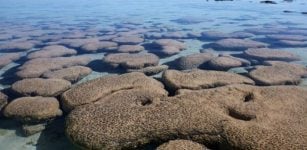Fluorescent Caves May Provide Insight Into How Life Survives In Extraterrestrial Environments
Eddie Gonzales Jr. – MessageToEagle.com – Deep below Earth’s surface, rock and mineral formations lay hidden with a secret brilliance. Under a black light, the chemicals fossilized within shine in brilliant hues of pink, blue and green.
A section of South Dakota’s Wind Cave seen under normal white light (left image) transforms into something otherworldly when placed under UV light (right image) Joshua Sebree
Scientists are using these fluorescent features to understand how the caves formed and how life is supported in extreme environments, which may reveal how life could persist in faraway places, like Jupiter’s icy moon Europa.
As it turns out, the chemistry in South Dakota’s Wind Cave is likely similar to places like Europa — and easier to reach. This is why astrobiologist Joshua Sebree, a professor at the University of Northern Iowa, ended up hundreds of feet underground investigating the minerals and lifeforms in these dark, cold conditions.
“The purpose of this project as a whole is to try to better understand the chemistry taking place underground that’s telling us about how life can be supported,” he explains.
Sebree and his students explored new areas of Wind Cave and other U. S. caves, mapping rock formations, passages, streams, and organisms. They also used UV lights to examine the minerals in the rocks.
Under black light, parts of the caves transformed as rocks glowed in various hues. These colors, due to ancient impurities or “chemistry fossils,” indicated different organic or inorganic compounds. The glowing stones often showed where water once carried minerals from the surface.
“The walls just looked completely blank and devoid of anything interesting,” says Sebree. “But then, when we turned on the black lights, what used to be just a plain brown wall turned into a bright layer of fluorescent mineral that indicated where a pool of water used to be 10,000 or 20,000 years ago.”
Anna Van Der Weide, an undergraduate, joins Sebree on explorations. Using fieldwork data, she’s creating a public inventory of fluorescence fingerprints to enhance traditional cave maps and offer a fuller understanding of its history and formation. Additional undergraduate students have contributed to the study.
Doing science in a cave is challenging. In the 48°F (9°C) temperature of Minnesota’s Mystery Cave, the team buried spectrometer batteries in handwarmers to keep them functional. To reach certain areas, scientists squeezed through spaces less than a foot wide for hundreds of feet, sometimes losing shoes or pants. They often stood knee-deep in freezing water to take measurements, hoping their instruments didn’t accidentally fall.
Despite these hurdles, the caves have provided valuable information. In Wind Cave, manganese-rich waters carved the cave and created striped zebra calcites that glow pink under black light. The calcites grew underground, nourished by the manganese-rich water.
Sebree believes that when these rocks shattered, since calcite is weaker than the limestone also comprising the cave, the calcite worked to expand the cave too. “It’s a very different cave forming mechanism than has previously been looked at before,” he says.
And the unique research conditions have provided a memorable experience to Van Der Weide.
“It was really cool to see how you can apply science out in the field and to learn how you function in those environments,” she concludes, and plans to confirm the fluorescence technique’s accuracy by comparing it to traditional methods. Another goal is to study fluorescing cave water to understand surface life’s effect on subterranean life and explore how mineral-rich water might support life in our solar system.










